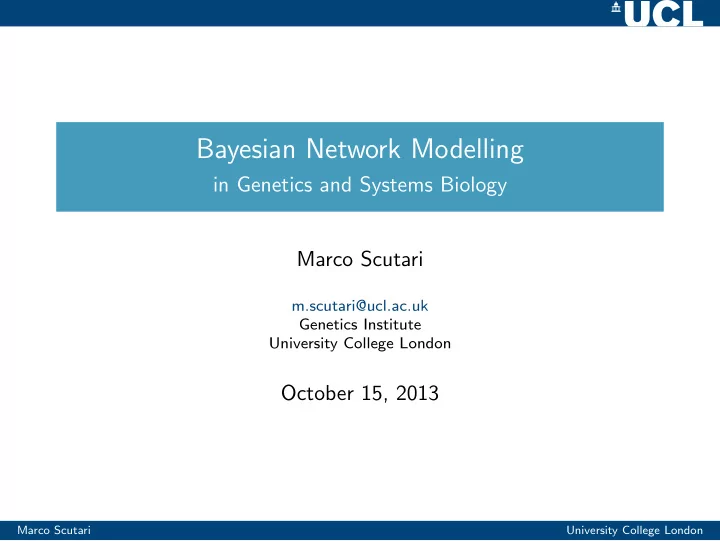

Bayesian Network Modelling in Genetics and Systems Biology Marco Scutari m.scutari@ucl.ac.uk Genetics Institute University College London October 15, 2013 Marco Scutari University College London
Bayesian Networks: an Overview A Bayesian network (BN) [14, 19] is a combination of: • a directed graph (DAG) G = ( V , A ) , in which each node v i ∈ V corresponds to a random variable X i (a gene, a trait, an environmental factor, etc.); • a global probability distribution over X = { X i } , which can be split into simpler local probability distributions according to the arcs a ij ∈ A present in the graph. This combination allows a compact representation of the joint distribution of high-dimensional problems, and simplifies inference using the graphical properties of G . Under some additional assumptions arcs may represent causal relationships [20]. Marco Scutari University College London
The Two Main Properties of Bayesian Networks The defining characteristic of BNs is that graphical separation implies (conditional) probabilistic independence. As a result, Markov blanket the global distribution factorises into local distributions: each is associated with a node X i and depends only on its parents X 1 X 3 X 7 X 9 Π X i , X 5 p � X 2 X 4 X 8 X 10 P( X ) = P( X i | Π X i ) . X 6 i =1 In addition, we can visually identify the Parents Children Markov blanket of each node X i (the Children's other set of nodes that completely separates parents X i from the rest of the graph, and thus includes all the knowledge needed to do inference on X i ). Marco Scutari University College London
Bayesian Networks in Genetics & Systems Biology Bayesian networks are versatile and have several potential applications because: • dynamic Bayesian networks can model dynamic data [8, 13, 15]; • learning and inference are (partly) decoupled from the nature of the data, many algorithms can be reused changing tests/scores [18]; • genetic, experimental and environmental effects can be accommodated in a single encompassing model [22]; • interactions can be learned from the data [16], specified from prior knowledge or anything in between [17, 2]; • efficient inference techniques for prediction and significance testing are mostly codified. Data: SNPs [16, 9], expression data [2, 22], proteomics [22], metabolomics [7], and more... Marco Scutari University College London
Markov Blankets for Feature Selection Marco Scutari University College London
Markov Blankets for Feature Selection Markov Blankets can Preserve Prediction Power Model ρ CV ρ CV,MB ∆ Predictions based Markov blankets may AGOUEB, YIELD ( 185 / 810 SNPs, 23% ) have the same precision as genome- wide predictions for large α ( ≃ 0 . 15) PLS 0 . 495 0 . 495 +0 . 000 [25]. The data: Ridge 0 . 501 0 . 489 − 0 . 012 LASSO 0 . 400 0 . 399 − 0 . 001 • AGOUEB ( 227 obs.): winter Elastic Net 0 . 500 0 . 489 − 0 . 011 barley, yield [30, 3, 21]; MICE, GROWTH RATE ( 543 / 12 . 5 K SNPs, 4% ) • MICE ( 1940 obs.): WTCCC PLS 0 . 344 0 . 388 +0 . 044 heterogeneous mouse Ridge 0 . 366 0 . 394 +0 . 028 LASSO 0 . 390 0 . 394 +0 . 004 populations, more than 100 Elastic Net 0 . 403 0 . 401 − 0 . 001 traits [27, 29]; MICE, WEIGHT ( 525 / 12 . 5 K SNPs, 4% ) • RICE ( 413 obs.): Oryza sativa rice, 34 recorded traits [31]. PLS 0 . 502 0 . 524 +0 . 022 Ridge 0 . 526 0 . 542 +0 . 016 LASSO 0 . 579 0 . 577 − 0 . 001 We observe no loss in predictive Elastic Net 0 . 580 0 . 580 +0 . 000 power after the Markov blanket feature selection. In fact, the reduced number RICE, SEEDS PER PANICLE ( 293 / 74 K SNPs, 0 . 4% ) of SNPs increases numerical stability PLS 0 . 583 0 . 601 +0 . 018 and slightly improves the predictive Ridge 0 . 601 0 . 612 +0 . 011 LASSO 0 . 516 0 . 580 +0 . 064 power of the models. Elastic Net 0 . 602 0 . 612 +0 . 010 Marco Scutari University College London
Recommend
More recommend